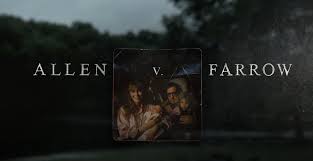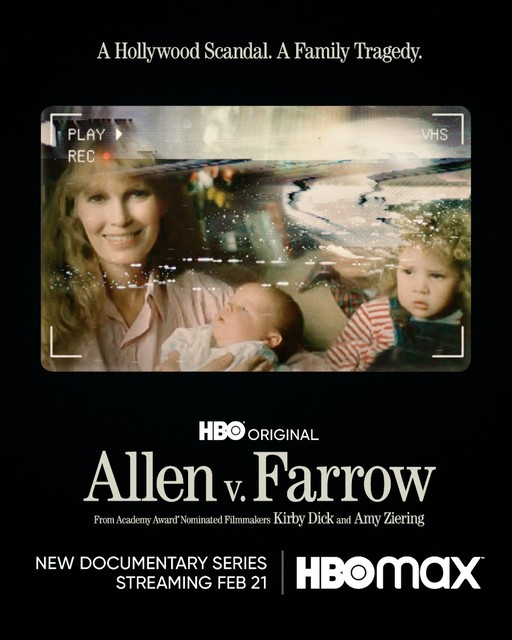Allen v. Farrow and the Death of the Artist

April 8, 2021
In 2014, The New Yorker’s Ronan Farrow published an investigative expose on Hollywood producer Harvey Weinstein. What happened next is history. #MeToo, an online social movement against sexual abuse, exploded onto the scene in Hollywood, with the likes of Bill Cosby and Jeffrey Epstein being exposed as men who abuse their power to silence those they harassed. The accusation and eventual conviction of Harvey Weinstein caused shockwaves across American media.
With the scathing new documentary Allen V. Farrow, directors Kirby Dick and Amy Ziering bring light to the aged – but no less outrageous – accusations of child molestation against Woody Allen. What connects this to the MeToo Movement is not simply that Woody Allen is Ronan Farrow’s purported father, the journalist who sparked the flame of one of the most notorious social justice movements of the decade, but the fact that what has kept all these men in the clear for so long is their celebrity.
Deftly split into four hour-long episodes, Allen V. Farrow takes a deep dive into Woody Allen’s family history, his alleged assault, and the highly publicized trial. Woody Allen and Mia Farrow maintained an unorthodox relationship for twelve years, living in separate estates with Allen allegedly claiming he wants “nothing to do” with Farrow’s seven children. As the years waned on their partnership, Allen eventually adopted Moses Farrow and Dylan Farrow. Mia became pregnant with Ronan in 1987. All of this occurred in the window of time where he purportedly groomed and assaulted Dylan. Allen was also found with pornographic pictures of Soon-Yi Previn, another of Farrow’s adopted children. He went on to marry Soon-Yi. Although Allen was never charged with sexual assault, the documentary strongly suggests that Allen tried to have the case buried by using his wealth and influence to tamper with the New York State and Connecticut State’s investigation by tampering with a Yale-New Haven Hospital’s psychiatric evaluation of Dylan’s sexual abuse allegations and paying private investigators to smear Mia Farrow. Allen allegedly tried to sway public opinion against her. None of the accusations, however, have been proven in a court of law.
Throughout the documentary, witnesses from family friends to Mia Farrow’s children appear to lend support to Dylan’s accusations of sexual assault against Allen. Child psychologists and police detectives previously in charge of the case also appear in the documentary, all in defense of Dylan and her story. Allen and Soon-Yi Previn declined to be interviewed. Stand-ins for his absence and lack of defense appeared in the form of Allen’s recent memoir, Apropos of Nothing. There was also a score of media journalists all testifying to the international fame and influence Allen’s films had on cinema and pop culture alike. As the high-profile case was underway in the early nineties, Allen did everything in his power to paint Mia Farrow as a “woman scorned,” coaching Dylan Farrow’s accusations and using her daughter to seek revenge on Allen for “falling in love” with Soon-Yi. Like Harvey Weinstein, who paid a slew of private investigators to smear those on his tracks, Allen abused his celebrity and influence to escape conviction.

The documentary posits that Woody Allen is indeed guilty, and it seems the tide has turned against Allen over recent years. Many of the actors who collaborated with him on previous projects, like Timothee Chalamet, Greta Gerwig, and Colin Firth have expressed regret for ever working with him. His most recent movie starring Chalamet and Selena Gomez, A Rainy Day in New York, never premiered in American theatres. However, PJ Grishar of The Forward asserted, “You’re not a New Yorker until you encounter Woody Allen.” Allen, a great purveyor of sympathy because of his beloved films and characters, is impossible to ignore in the American mythos. This begs the question: is it possible to still revere the art independent of the artist himself? Allen V. Farrow attempts to answer this very question. Although the topic itself is nuanced and can vary from case to case, the expose contends that in the case of Woody Allen, there is not a separation between himself and his films. They cite the example of his film Manhattan, a story about a 42-year-old man’s relationship with a 17-year-old girl which garnered Academy Award nominations and much acclaim. The documentary posits that the film, and many of his other works that feature relationships of a similar nature, all serve to normalize this kind of predatory behavior. The fact that Allen also used his monetary success to defame both Mia and Dylan Farrow makes the line separating him from his work more blurry.
The discussion of separating the art and the artist has been ongoing and has seen a resurgence, particularly in recent years. The list of the accused ranges from such revered historical figures as Abraham Lincoln to Picasso. Even Doctor Seuss has faced his fair share of scrutiny, with his estate deciding to stop publishing several of his books that contain racist caricatures. Living in a cultural moment fraught with controversy, we are facing a form of reckoning, and although there is no conceivable way of halting this period of judgment, it is possible to continue consuming these individuals’ art through a more critical lens. We can continue to admire their art and read their books, but we must do it with the knowledge of these individuals’ potential biases because ultimately their art is a reflection of their values. Adjusting our perception of society’s “best” will be difficult, but it may be worth it to reject the idea that these individuals are somehow people we know personally — because when we are so consumed by our desire to cradle them in our collective conscience we turn a blind eye to the victims who suffered at their hands.
As we move into 2021, we begin to hold more and more of those in power accountable. However, we face the difficulty of changing our perceptions of individuals who hold such a special place in our hearts. It will most definitely be impossible to avoid Mr. Allen’s influence on the media and our cultural phenom, but maybe what is required is not to censor these individuals’ works entirely. Instead, we need to be able to scrutinize what we may have blindly praised before. As for the ones who suffer because of our acquiescence like Dylan Farrow, we must all be ready to rally behind those brave enough to come forward when the odds seem impossibly stacked against them.




